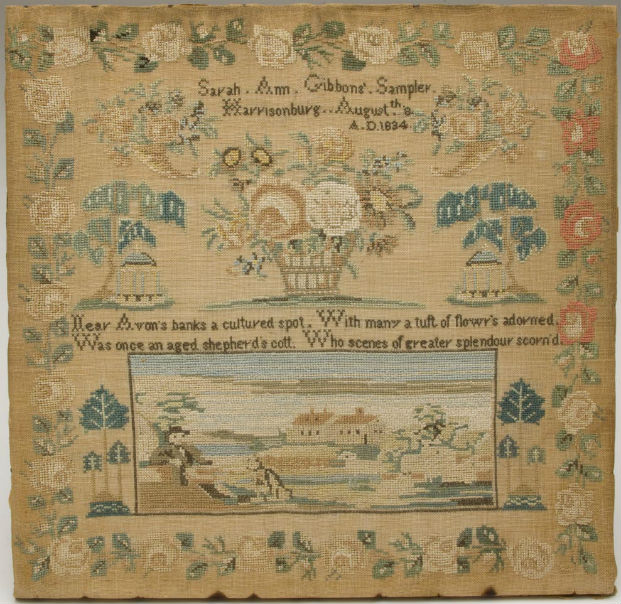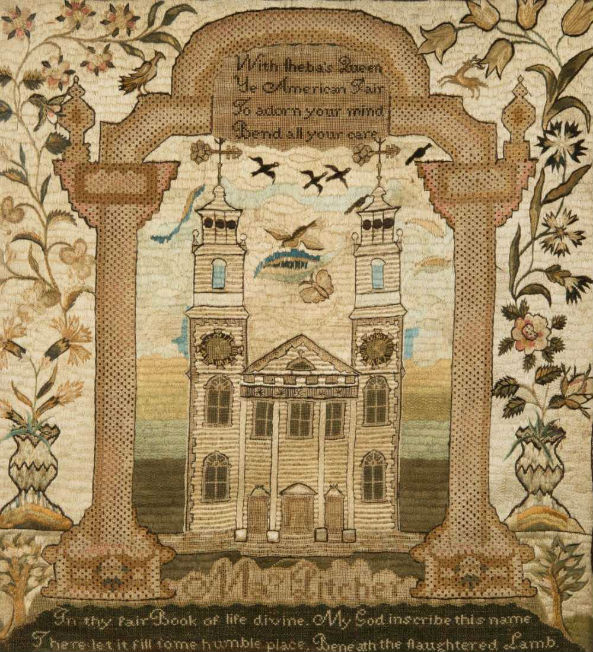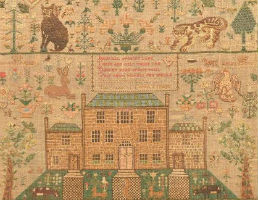
NEW YORK – Schoolgirl samplers have long been sought after by collectors. You might even call them the triple threat of the antiques world. While they don’t sing, act and dance, they are loaded with great graphics, nostalgic appeal and have great stories to tell.
Collectors gravitate to them as they are highly personal items that resonate strongly with people today. More than just being wonderful examples of folk art, samplers are deeply personal artifacts that teach lessons about the history of education in America. They are tangible reminders of the drastic shift in the material culture of America, when two centuries ago learning needlework was a critical part of a girl’s education, giving them necessary skills in embroidery that they would later need to run their own home versus today, when home economics is no longer a staple in some schools.
Alphabet samplers are fairly common and well collected but ornate pictorial examples are highly coveted, whether depicting buildings, people, landscapes or animals. While samplers have been wrought in Europe as early as the 16th century, we will focus on American samplers in this article. The earliest known American sampler was wrought by Loara Standish in the Plymouth area of Massachusetts, circa 1645, according to the Smithsonian’s National Museum of American History. A half-century later, many schools had sprung up from New England to the greater Philadelphia area, teaching young girls from well-do-do families the needle arts and other necessary skills. Samplers worked on linen gave girls as young as 6 years old the chance to hone their artistry.

A band sampler made by Sarah Stone and dated 1678 is another early example in the renowned antique textiles collection of Delaware’s Winterthur Museum. Band samplers are the most traditional forms of samplers, featuring clean rows (bands) of stitches, usually letters, numbers or verse. The sampler’s creator usually would finish off their creation with their name and age, the date completed and sometimes the name of their school or teacher.
Many museums share private collectors’ passion for samplers and have acquired fine examples and mounted exhibitions studying this art form. Samplers of interest range from the youngest of girls’ samplers, where the most basic stitches would render a simple alphabet design, to advanced samplers from older girls, featuring silk thread instead of embroidery floss to render elaborate pictorial works.

A featured sampler in the Milwaukee Public Museum’s past exhibition “ABCs of Schoolgirl Samplers” was one by Mary B. Hammond, a clearly advanced student at the time whose sampler reflects her mastery of embroidery skills. It depicts a New England-style village inn in the center under rows of alphabet letters and along with other pictorial elements such as fruit trees, a garden gate, clouds and a cat. “Her charming sampler reveals a young girl’s burgeoning needle skills and ability to design her own unique work by artfully filling its surface with architecture, foliage, sky and objects of both sweet sentimentality and real importance to her unnamed village,” according to commentary on the museum’s website.
Michael B. Grogan, founder of Grogan & Company in Boston, said the age and the level of detail of a design in a sampler as well as its condition are among the factors that make a sampler valuable. “Pre-19th-century schoolgirl samplers are scarce,” he said. “Finding a pre-1825 American sampler in good condition with a complexity of well-balanced design elements is a collector’s goal.”

Architecture (churches, schools, country homesteads) is a popular motif in samplers as well as birds, flowers, trees, human figures, and animals. Popular and inspirational verses (secular or Biblical) are also desired and samplers were usually finished off with decorative and ornate borders.
“Naturally, the alphabet, numbers and poem or verse of some sort are the starting point,” Grogan said, naming attributes of desirable samplers. “The stitcher’s name, age and hometown are desirable, too. Finally, an abundant design including birds, flowers, figures and architecture can combine to make a sampler ultra-collectible … the best examples capture an immense amount of charm, artistry and skill.”
Besides teaching embroidery skills, samplers were all about espousing character and moral messages. Typical inscriptions were such pleadings as “Let virtue be/ A guide to thee,” implored by Sally Russell of Smithfield, Rhode Island, in a circa 1810 sampler, or “Learn Your Duty And Do It,” from Lucy Ann Smith, aged 7, in a sampler dated 1812.”
Although there were many schools around back then, teaching young women the needle arts, including those in Connecticut, New York, New Jersey, Massachusetts and Pennsylvania, the Balch School in Providence, R.I., produced many great examples, Grogan said. “Many of the best schoolgirl samplers have the city or town stitched as a part of the design,” he said.

New collectors entering the market would do well to research samplers and became educated on the subject. A landmark book, considered by many as the Bible on samplers is Betty Ring’s two-volume Girlhood Embroidery: American Samplers & Pictorial Needlework, 1650-1850.
“Assuring good condition is a key issue. Buy only after reading up on the subject and visiting museums and dealers,” urged Grogan. “Go to antique shows. Much has been written about American samplers, and many exhibitions have been mounted, which fuels collector interest.”
New collectors can pick up simple samplers with basic ABCs and numerals for very reasonable prices, while prices rise exponentially for more elaborate pictorial samplers, particularly when a school or maker can be identified.
Collectors seeking out samplers with strong color, great condition and robust imagery would do well to heed Ring’s oft-repeated advice: “Collect the best you can, look for quality, not quantity.”


